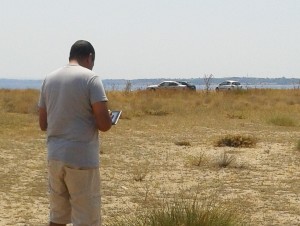Yet more bad news from USDA. Gary Kinard has just informed us of the death of Gorm Emberland. We reproduce his email below. Like Mark Bohning, who also tragically passed away only a few weeks back, Gorm worked at the National Germplasm Resources Laboratory in Beltsville, MD. He was an IT specialist, and I first met him many, many years ago, in Trinidad I think it was, during a training course on pcGRIN, a desktop version of the USDA’s genebank documentation system that he largely wrote. That had some success at the time, and led to a continuing interest on USDA’s part in supporting genebanks around the world in managing their data. The latest evidence of that is, of course, GRIN-Global. Our thoughts are with Gorm’s family and colleagues.
I am tremendously saddened to share with you the news that Gorm Emberland, an IT Specialist with the National Germplasm Resources Laboratory in Beltsville, MD, died this morning at age 54 in Georgetown University Hospital in Washington D.C. Gorm had a chronic medical condition that had worsened over the past several months; he contracted pneumonia recently and things got steadily worse over the last several days.
Gorm was a lead software developer on the Germplasm Resources Information Network (GRIN) system that is used by the U.S. National Plant Germplasm System (NPGS), and which also supports the entire ARS genetic resource collections. A significant amount of the software that is used by the NPGS today was written by Gorm. He was a productive and dedicated developer who was passionate about his career.
Gorm first started with ARS as an undergraduate student employee in 1978, working in the computer room at the National Agricultural Library. He obtained a B.S. degree in Zoology from the University of Maryland-College Park in 1981. He was captivated by the emerging field of computer science and obtained a B.S. degree in it, also from UMD, in 1986 while he concurrently worked for several local private computer companies. In 1991, he returned to ARS as an IT Specialist in the National Germplasm Resources Lab to work on the GRIN project. He was the lead developer on a project called pcGRIN that shared our information management system freely with international genebanks. Gorm was well known and highly regarded among both the U.S. and international plant genetic resource communities.
This news especially painful for those of us in the NPGS, coming less than 8 weeks after the death of another long time NGRL employee — Mark Bohning. Gorm and Mark were friends and colleagues for more than 22 years. This is a difficult time for many who knew them both, the sudden loss of 55 years of collective experience working with our Agency’s genetic resource collections, and another wonderful person to die much too young.
Gorm is survived by his wife, Dr. Joan Emberland; a daughter, Annie; and a son, Colin. In addition, the entire BARC family grieves with Chris Pooley, an IT Specialist in the BARC IT and Soybean Genomics and Improvement Lab groups, who was Gorm’s brother-in-law.
